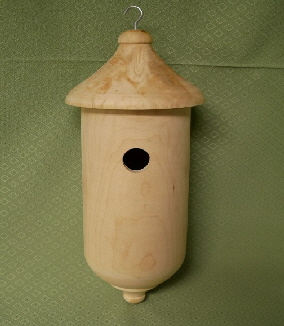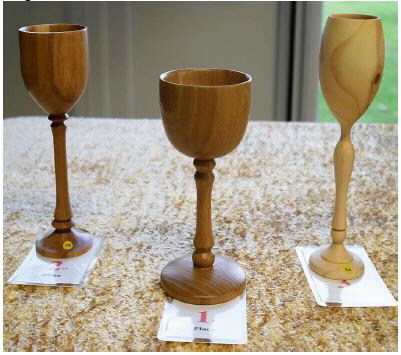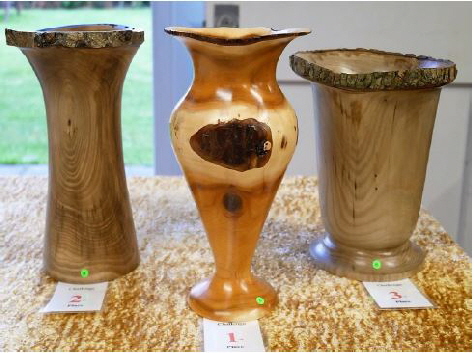Shropshire Association of Woodturners
Event Reports for 2017
2017 started with our January ‘woodfest’ and about half of our members made the effort and picked up some real bargains. The club took about £100 but there’s still a lot of bargains for each of you at future meetings this year.
The afternoon got off to a shaky start as Trevor (the Bicton Hall Secretary) had not deconflicted our meeting with a 65th birthday party that evening. Clearly Trevor hadn’t looked at both (!) of his diaries when he’d said that the party people could set up the room during the afternoon (or they just assumed they could…). Diplomacy was called for and a compromise was achieved by us moving into half of the room and drawing the screens across. Maybe if more members had been there we’d have been pushed to circulate in ‘our bit’. I’ve never seen such a lot of sour faced ladies setting up a party. I hope for the sake of the birthday boy they lightened up before the party!
The Challenges
I was pleasantly surprised by the number of entries in both categories that were submitted considering the numbers attending. The Turners’ challenge was ‘A favourite item not previously entered’. There were 5 entries from 3 members and having ‘elevated’ both Martin Davies and Joe Sims to the ‘higher echelons’ the field was clear for new winners. First and third places were won by Dave Fletcher and second place by John Griffiths. Well done gentlemen, really good turning. The Advanced Turners had to make a platter (between 7 and 10 inches across) that would fit through a 1 inch slot. There were 7 entries from 5 members (recently bolstered by Martin and Joe). First place was won by Tim Aaron, second by Martin Davies and in joint third place two of John Gibbons’ platters. Congratulations to you chaps too.
February’s challenges are:
Turners – A Platter 5 to 8 inches in diameter to fit through a 1 inch slot.
Advanced Turners – A bowl 5 to 8 inches dia. textured, stained and/or pierced.
Good luck and happy turning.
Tim Aaron
March Demonstration by Emma Cook
Emma (also self-styled as ‘The Tiny Turner’) was a welcome ‘new to us’ turner on 22nd March. There was an almost full membership turnout for her demo and we were treated to a display of carved decorating of turned pieces. There were many examples of Emma’s work for us to see before and after her demo.
Her demo began with a comprehensive display of the making of a carving mallet. Emma showed us how the head should be turned ‘cross grain’ so that the two sides of the mallet which had end-grain visible would be used as the striking area (the other two areas would splinter and break away). The side effect of hitting with the end-grain areas was that a harder, more compact striking area was produced. Having produced the mallet head and drilled it through she turned the handle with a long spiggot to go all the way through the head. This spiggot would be cut lengthwise to take a long wedge to lock the two parts together. Having completed the turning and to avoid sanding dust, the two components were donated to the club to apply a finish that we wanted.
After the break Emma quickly produced, from lime wood, a small box which was shaped like a cup cake and demonstrated the carving of the fluted ‘bun case’ and ‘swirled icing’ top (lid). . We learned lots about which carving chisels to use to achieve various effects and importantly, how the chisels were sharpened. Obviously not many of us carve our work but there’s no reason why we couldn’t incorporate that sort of embellishment into the decoration of our turned pieces especially for the items we don’t want to stain or colour in some way. All in all it was a very interesting and inspirational demo. Thank you Emma.
Tim Aaron
Steve Heeley Demonstration 24th May 2017
There are experts – I’ve known a few – who are so absorbed in their own expertise that they’ve lost sight of how anyone else couldn’t know or do what they do. They make the worst teachers. On the other hand, there’s Steve Heeley – as good a teacher as he is woodturner. His expertise with wood is evident in his stunning display of finished pieces and his effortless facility on the lathe. His skill as a teacher is more subtle, less on show – and in Steve’s case, entirely natural. What was the first thing he did? He checked his audience – “any beginners?” – so he knew where to pitch his delivery. And he didn’t lean on his lathe as though a lectern and lecture us, he got on with it. He gave us all something to capture our attention and then a commentary on what was happening – comments that weren’t idle descriptions, but each one an explanation, a valid learning point or a point to ponder. All that laced with West Midland humour made it entertaining and engaging. Which is not to say he was flippant. There were the serious moments – the Health and Safety issues – all the more pertinent for being personal.
What did Steve make? An elegant candlestick and a beautifully simple ash bowl. Relevant? The how rather than the what is more significant for me. I might never want to make a classic candlestick, but I turn faceplate and spindle of course. I will no doubt want to join a base and a “stick”. I want to work as comfortably as he does – to pick up the skew chisel with such confidence; to shear cut and then shear scrape with the right ground gouge and that lightness of touch for that faultless finish; to follow the outside line of the bowl with such smooth facility without constant calipers. I came away with all that ambition afresh.
Steve is fast – not because he hurries (on the contrary, he relaxes) – but because he is prepared. Tools are to hand (no rummaging around in boxes of clutter); holes are pre-drilled, chucks are ready. Need to measure? Estimate – check – flash of a pencil stub – done! At times, learning with Steve is almost subliminal. There is no point in trying to cover all the points and tips. If I could write that fast I would have accumulated a comprehensive training manual. Demonstrations like this should be filmed and produced as training videos.
What Steve does works for him – but he is not prescriptive. Steve’s mantra – “if you don’t like it, don’t do it” leaves the door open to alternatives, experiment and creativity. Steve inspires. I will try to use my roughing gouge less. I will pay attention to how I cut blanks for drying so the wood will dry better and will look its best.
Maybe all this was old hat to more experienced and accomplished turners – but it’s still a rich source of information, timely reminders and inspiration for the likes of me.
Steve informed us that our next demonstrator is a “student” of his. If he has taught him as much about demonstrating as about turning, I look forward to another invaluable session. As I said, there are ordinary experts, and there’s Steve Heeley.
Graham Patient
Robert Till Demo June 28th
Robert Till is clearly a skilled turner – his display of work showed that. But how refreshing to demonstrate a project that didn’t involve fancy finishes and polish – an attractive bird nesting box with a rounded bottom, hollowed out of one large piece of a tree branch with a removable top so that it could be opened and cleaned after the nesting season is over.
It was a well-judged demonstration – low-risk, confident and with enough commentary, tips and explanation to keep most of us, at least, attentive. For once I was as interested in the product as in the process – and Robert’s passing round a finished sample and a free copy of the plan early on made it easy to follow. With a nice bit of “Blue Peter” forethought, a lengthy procedure was made to fit the evening comfortably without losing any essential steps. How long it will take to hollow out all that interior without a £150 hollowing tool I am not sure. Can you get a 4inch forstner bit?
Fortunately, the inside is where the young birds need a nice rough surface!
Exterior features and shapes were pleasingly free-form (I like some leeway!) – but some measurements like the diameter and position of the hole are crucial for the birds’ safety and comfort. The finish from the sharp wing of a roughing gouge was perfectly fit for purpose. It was reassuring that the design (size, flexibility, cleanability etc.) was informed by RSPB expertise – and that Robert could cite personal evidence of its successful adoption in the garden. Blue tits rarely struggle for a nesting site but it would be delightful to watch some popping in and out of such an elegant home.
It was a relaxed, low-key demonstration with a very practical outcome, and well received. It was an enjoyable and rewarding contribution to the year’s varied programme of club events
.Graham Patient

Club/Visitor Evening July 26th
We had a very good attendance of members plus some visitors who all enjoyed the various activities on offer and we would like to extend our thanks to Martyn, Ian and John for manning the lathes and sharpening table. These evenings are much more informal than when we have a demonstrator booked to attend and it allows more opportunities to ask questions and get some very useful hints and tips on those little problems that crop up! Plus, just having a good natter of course.
These are the winning entries in July’s challenge, Turners and Advanced Turners


August Meeting
Bob Neill was our demonstrator in August and we had a really good turn-out of members and visitors. Bob is a renowned pyrographer and gave us a very interesting and informative evening. He brought with him a massive selection of examples of his work and spent the first half of the evening explaining the different techniques and tool shapes that produced the stunning effects The audience was totally absorbed and fascinated by what could be achieved with the various interchangeable wire tips that could be used. He also showed us how to enhance our work with colouring from using simple felt tips, artists acrylic paints on up to metallic finishes and even a thin layer of gold was applied to one piece!
After the break for coffee, tea and cakes it was time to get our ‘hands on’. Bob had brought along 16 sets of equipment which were laid out on tables and were in constant use as members and visitors took their turns (with varying degrees of success!). Bob and his very knowledgeable wife were there to guide and answer the inevitable questions and discussions with him from the evening’s participants wanting to know more and between members.

t was a well thought out and balanced evening demo and ‘hands on’ by Bob and well appreciated by those who attended. Thank you Bob.
Tim Aaron


NB – if any of you want to buy the kits – Bob does sell them at a good price. He also sells all the accessories and extras. You can get in touch with him via his website or tel 01332 792036. His email is bob.neill1@btinternet.com Editor
Mark Baker Seminar
On October 28th we were privileged to have as our demonstrator the editor of Woodturning magazine, Mark Baker. Approximately 33 members and visitors (local turners and members of the Staffs and Mid Wales clubs) enjoyed a brilliant day of turning, advice, technique and banter.
By not taking up time sanding the items, Mark raced through each project giving us the inspiration and the procedures to attempt the various items. Form and finish feature highly in an item’s appeal (for display or sale) so he stressed those attributes as he went through the turning of each project.
To call the next item a tea light holder would do it a great injustice. The item was to have a square base supporting a ‘Grecian vase’ form and was discussed and explained during the turning process. The need for a heat barrier insert for the tea light (also required for a candle) was explained. Then he showed how, instead of using the stand for a tea light, one could turn a shallow platter with spigot to locate in the recess (instead of the tea light insert) to produce a tazza. Discussion with the audience decided on the most pleasing size of the platter to keep the assembled pieces in the correct ratio.
A demonstration of staining with multiple colours of the rim of a shallow bowl/platter was next. Mark acknowledged that our fraternity is well split on whether to colour our work or to leave it plain. That debate is never going to produce a definitive answer so I suppose it’s best to leave it as a matter of choice. He used three stains on the rim, gently sanding back the first two. The stains take a little while to dry so in the intervening periods we were entertained by his demonstration of turning a three-cornered bowl from a cube of wood held, to start with, between opposite corners. A very good surprise and a good way of highlighting the safety aspects of turning items with sharp edges!

First was a large bowl from which he ‘saved’, by coring, the wood that would become the lid. Design and form were explained and then produced speedily. Once he’d completed the turning (but not sanding) Mark very kindly donated the item for the raffle for whoever won it to ‘finish it off’. Thank you.

Overall the day was exactly what we needed for a seminar and was delivered by Mark in an expert way. Inspiration and techniques abounded throughout and were drunk in by an appreciative audience. Very many thanks Mark.
A footnote (literally!! Haha!)
As has become usual (the last three years!) we were again fortunate to have a hot meal at the lunch break. That statement doesn’t carry enough weight to recognise the hard work put in by Carol and John Gibbons.
The sourcing, cooking and serving of our meal, together with their granddaughter, Stacey, doing sterling work serving and washing up, deserves our grateful thanks again. The thanks shouldn’t stop there.
The publicity and organising that Carol does as our Hon Secretary ensured that the seminar was as well attended as it was. Grateful thanks go to Carol from us all for her part in the success of the event (and to John for his veggie peeling!).
Finally, when the financial ‘ins and outs’ were totted up by Andrew it showed that we had covered our costs. Tim Aaron